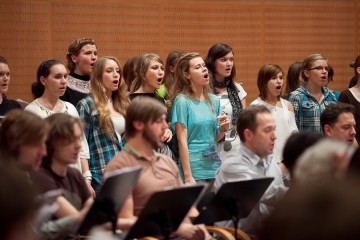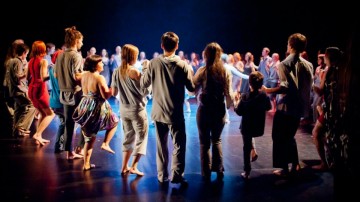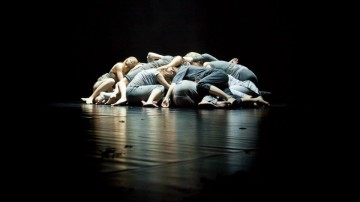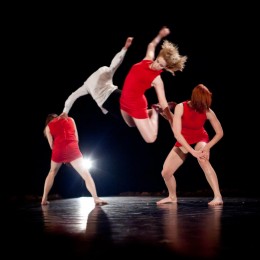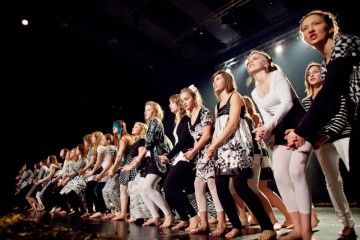On 8 December, 2011, the premiere of Chorea Theatre Association’s Oratorium Dance Project, Łódź’s cavernous Wytwórnia, a former film studio, was packed. On 9 December, the second and closing night, the space was oversold; audience members climbed ladders into balconies, crowded the aisles, and huddled at guardrails. Robert Hayden’s dancers were flanked to the left and right by choirs; in front of them was the Łódź Philharmonic.
The ninety-minute Oratorium consisted of ten new compositions for singers and orchestra by Chorea Theatre composers Tomasz Krzyżanowski and Maciej Maciaszek, along with an ancient Christian hymn, Lythaneo. Hayden’s choreography spanned the entire piece. The project was, in part, inspired by Chorea’s work with ancient Greek music, in the Grotowski-derived, Gardzienice-cultivated Polish theatre tradition. However, Krzyżanowski and Maciaszek are attempting to create something more than an adaptation of existing sources; their Oratorium drew on jazz, polyrhythms, and the sustained repetitions of post-minimalism. It was unmistakably contemporary.
Chorea
Theatre Association, based in Łodź, which runs a theatre and education centre offering a series of cyclical theatre, music and dance workshops, focused on work with the human body, voice and rhythm, as well as concerts and theatre performances. Artistic director: Tomasz Rodowicz.
Apart from the Oratorium project, Chorea’s Po Ptakach (After the Birds, 2005) was performed in Moscow’s Meyerhold Center on 19 and 20 December, 2011, as part of the cultural programs of the 2011 Polish EU Presidency. Grotowski: próba odwrotu (Grotowski: an Attempt to Retreat, 2010) will travel to Delhi and Amritsar, India 7-17 January, 2012, for the 14th Bharatrang Mahotsav Theatre Festival, organised by the National School of Drama in Delhi.
Future projects include a new adaptation of Euripides’s The Bacchae. Rehearsals begin in February 2012. This is Chorea’s third take on the text, after Bakkus (2006) and Songs of Euripides (2007). Oratorium choreographer Robert Hayden will return for this project. The Bacchae is scheduled to premiere on 26 or 27 March, 2012, TBA.
Oratorium had no over-arching plot; the texts, sung in Greek and in Polish, were a collection of ancient choruses. Krzyżanowski’s choruses were from Sophocles’ Antigone and Euripides’ Bacchae, Orestes, and Iphigenia at Aulis; Maciaszek’s were from Limenios’ paeans to the gods, including Apollo, Artemis, and Zeus. The songs were thematically linked through the idea of the chorus, the consistent looping, repeating quality of the music, and the strikingly large number of performers on stage.
The production included over a hundred community participants, along with Chorea and the musicians of the Łódź Philharmonic Orchestra and Choir. This project was conceived of three years ago by the second-generation Łódź opera singer Mateusz Cieślak, the organiser and coordinator of Oratorium; he was inspired by similar community-based work by the UK’s Dance United. Chorea Theatre artistic director Tomasz Rodowicz guided the project to completion. The cast ranged in age from 7 to 60. Many of them had never before performed professionally. Teenagers from local high schools and community organisations, including a reform school and an addiction treatment centre, young children, and adults, all took part.
What follows are excerpts from a rehearsal diary of an outside observer, from the week before opening.
Friday, 2 December
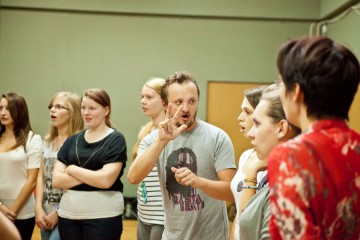 Janusz Adam Biedrzycki with student performers,
Janusz Adam Biedrzycki with student performers,
photo: Photomafia.pl
The student chorus, the Chór Młodej Chorei (The Choir of Young Chorea) meets in a Łódź high school classroom – the geography room, with colour maps on the wall. The room fills with young singers and Chorea performers: Dorota Porowska, Elina Toneva, Jakub Pałys, Dominika Jarosz, Joanna Chmielecka, and others. Composers Krzyżanowski and Maciaszek are here too. They’ve been rehearsing together since 17 October.
The responsibilities of leading the rehearsal are shared between the Chorea performers. Pałys, Krzyżanowski, and Maciaszek form a three-man chorus of conductors in front, accompanying with the harmonium and cajón box drum. Their hands move in unison. Jarosz, Chmielecka, Toneva, and Porowska sing within the student choir. They lead from inside their vocal sections, with hand gestures and their eyes. The chorus claps throughout the song, providing its own rhythms. If the teenagers grow restless, Jarosz reminds the kids, “This is not a break!”
Upstairs, in a wood-floored ballroom, the dancers begin the sixth piece, Maciaszek’s Allo Phoibe. Rodowicz and Hayden watch intently. Performers streak from one corner to another at car-crash speed. I end up in a corner, behind a pack of dancers, including Chorea member Janusz Adam Biedrzycki. He helps the students remember when to make their passes across the stage. Oratorium, like a football game, requires a team of assistant coaches.
Monday, 5 December
First rehearsal with the Łódź Philharmonic Orchestra and the Łódź Philharmonic Choir, directed by conductor Grzegorz Wierus. Krzyżanowski and Maciaszek have never heard the orchestra play Oratorium before; they’ve been working with a MIDI recording. Everyone, including the professional musicians, is finding the rhythms a challenge. After the orchestra rehearsal is over, the singers gather to keep working. The chorus forms concentric circles around the three conductors. It’s already been a long day, but they rehearse for two more hours. A young dancer, half-asleep, leans on her father as he sings.
Tuesday, 6 December
This evening is the first time I hear the tenth song, Krzyżanowski’s Makar Hostis. A group of cavorting children is surrounded – first by a procession of dancers, and then by an outer ring of singers. The dancers hold hands as they dip, bow, or turn. Linking the circle, with held hands, recalls the images of choral dancers that wrap around Greek vases. As the circle continues to turn and turn, a sense of being present at some strange rite of an ancient mystery religion grows. After the last words of the piece, Makar hostis, the chorus collapses to the ground.
The next and final piece is Lythaneo, Krzyżanowski’s arrangement of early Christian sacred music. The white-robed young soloist Elizabet Araj sings once through the entire hymn as the only standing figure on stage. The second time through Lythaneo, the reincarnated chorus sits up to sing with her. The third time through, the performers stand, come downstage, and sing directly to the audience: “Amen, Amen”.
Wednesday, 7 December
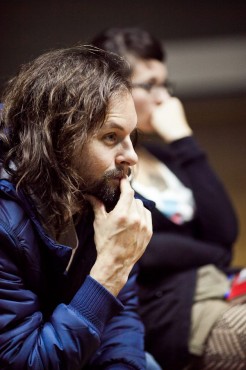 Robert Hayden, photo: Photomafia.plAn evening dress rehearsal, day before opening: the team works through Oratorium, from the beginning. But just when the ninth piece, Met Emoi, is about to begin, the orchestra’s window of rehearsal time ends. They start packing their bows and horns while the dancers, in costume, are poised for another number. Rodowicz and Chorea staff huddle by the sound board, discussing the situation. Assistant choreographer Aleksandra Ścibor calls from the stage, asking for the recorded music. After a few minutes, someone in the booth locates the CD, and the dancers are able to finish the section they were working on. But the disappointment in the room is strong. It’s the night before opening, and they haven’t been able to complete a run-through of the whole show.
Robert Hayden, photo: Photomafia.plAn evening dress rehearsal, day before opening: the team works through Oratorium, from the beginning. But just when the ninth piece, Met Emoi, is about to begin, the orchestra’s window of rehearsal time ends. They start packing their bows and horns while the dancers, in costume, are poised for another number. Rodowicz and Chorea staff huddle by the sound board, discussing the situation. Assistant choreographer Aleksandra Ścibor calls from the stage, asking for the recorded music. After a few minutes, someone in the booth locates the CD, and the dancers are able to finish the section they were working on. But the disappointment in the room is strong. It’s the night before opening, and they haven’t been able to complete a run-through of the whole show.
Thursday, 8 December: premiere
The singers have gathered early, but there will be just one more hour of rehearsal with the orchestra, from 19.00 till 20.00, right before the performance begins. The atmosphere in the Wytwórnia is tense, but Wierus conducts calmly and efficiently, fine-tuning, focusing on segments within songs.
At 20.00, the ensemble meets onstage for some final words of encouragement. Hayden: “You’ve done more than I ever could have expected.” Rodowicz speaks next, in a quiet voice. Everyone listens closely. After his short speech, the students laugh and bound offstage with new energy.
20.30: It begins. The first two songs, both by Maciaszek, create ominous scenes. It`epi Teleskopon: Jarosz in a white dress, buffeted by a band of wandering monsters. Alla Latous: A band of skipping children calling out “We’re starting! Where are you guys?”. They are swamped by the chorus, flooding past them in menacing waves.
Hayden’s choreography is full of conflict and transformations. For example, at the end of the fifth piece, Krzyżanowski’s Katolophyromai, in a brief minute of music, this sequence unfolds: (1) two aggressive choruses collide; (2) the choruses break up into fighting couples; (3) the fighting couples wrestle so closely that they become hugging couples; (4) the hugging couples turn to stone.
Hearing the entire piece makes it even more evident that post-minimalist-esque repetition is the predominant mode of Oratorium. The music is incantatory, hypnotic, lulling. An underlying phrase often continues, unvaried, throughout a song. Occasional vocal solos, and the conflict-charged dances, provide contrast.
When it’s over, after Lythaneo, the chorus of students and dancers applauds back to the applauding audience.
22.00: Party in the Wytwórnia lobby. Champagne. The exuberant teenagers chant and clap for one name after another. For the composers: “Ma-ciek-To-mek! Ma-ciek-To-mek!” For the production: “O-ra-to-rium! O-ra-to-rium!”
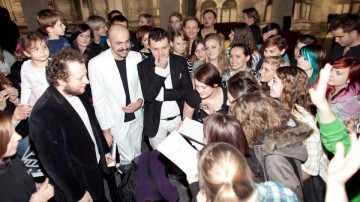 Tomasz Krzyżanowski, Maciek Maciaszek, and Jakub Pałys
Tomasz Krzyżanowski, Maciek Maciaszek, and Jakub Pałys
at the cast party, photo: Photomafia.pl
Friday, 9 December
After the oversold second night, the students are subdued. They’ve gone from opening-night exhilaration to the sadness of closing in 48 hours.
Tuesday, 13 December
I meet choreographer Robert Hayden for an interview at a cafe on ul. Piotrkowska down the street from the sidewalk stars on the HollyŁódź Walk of Fame. Hayden speaks about wanting, with the team, to create a “red thread” of imagery to follow through the show – an appropriately Greek reference, perhaps, to Ariadne and the labyrinth:
“What is this performance about? (...) It’s about these kids, but we don’t want to do a show that says ‘It’s about these kids.’ It’s more... how can we work with this material in such a way that it provides images, or creates images, that give people the sense of creating their own story, creating their own journey through it – through the performance. (...) Somewhere, there had to be a red thread, but this is important for us – not for the audience. Their red thread can be different from ours.”
Wednesday, 14 December
I conduct interviews with Krzyżanowski, Maciaszek, and Tomasz Rodowicz. We sit in Chorea’s archives in Łódź’s Fabryka Sztuki, surrounded by file folders. They’re getting ready to take Po Ptakach (After The Birds), their 2005 Aristophanes adaptation, to Moscow as part of the cultural programme of the 2011 Polish EU presidency. It’s a frenetic time. The truck has to be packed. Cieślak has been dispatched to Warszawa to pick up the visas.
I ask Rodowicz for a brief quote, quickly, since he’s busy. He says that it’s “impossible” for him to speak quickly: “[Oratorium] takes two years of my life from idea to preparation. (...) It is the biggest project, ever, I have made.”
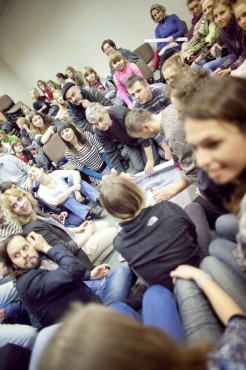 Tomasz Rodowicz and Chorea staff sign
Tomasz Rodowicz and Chorea staff sign
posters for students, photo: Photomafia.plHe emphasizes that “everybody, everyone, from Oratorium is coming out different from this project, than he was coming in,” but he is most proud of the growth shown by the student participants. “They became very responsible, very concentrated. They changed their attitude during the process of the work. And they changed themselves to be able to take part… You don’t see it from outside. You can see a kind of energy, joy. But you don’t see the changes, every day, coming from the work. The depth. The changes, inside.”
That evening, about a hundred performers meet for a goodbye party in a Fabryka Sztuki conference room. Folding chairs. Cookies and pretzel sticks. Rodowicz gathers the Chorea members and project artistic staff around a stack of colour Oratorium posters and markers. He says that the team will sign a poster for everyone who shares their worst experience from the project. I am surprised, but as the students chime in, it turns out that this is an effective technique for getting a group to talk. Amid giggling and groaning, they share horror stories and acknowledge the difficulty of the process. After all, the best experience, for many of them, was probably one of the performances; asking for the worst experience brings out a variety of funny anecdotes. The mood in the room is light.
When it’s time for one of the smallest girls to speak, her story is drowned out by the chatting teenagers. Repeated cries of “Cicho!” (Quiet!) have no effect. Suddenly, Pałys hoists the child onto his right shoulder, and stands up, above the crowd. With his encouragement, she becomes louder and clearer, until the entire room can hear her. I think of Rodowicz’s words: “The changes, every day, coming from the work.”


